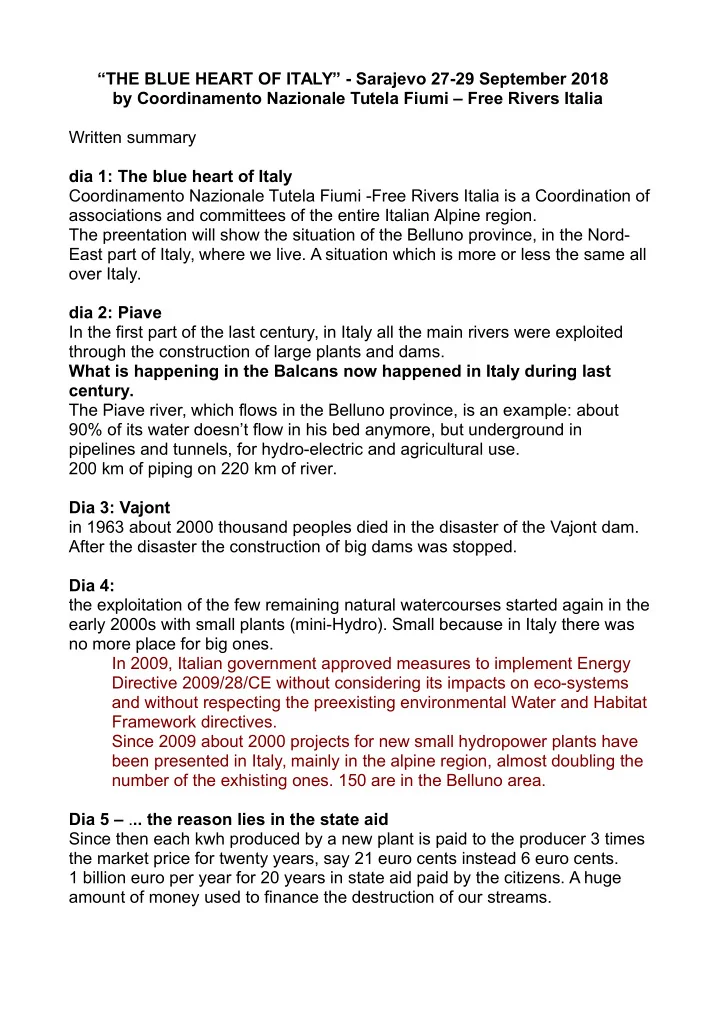

“THE BLUE HEART OF ITALY” - Sarajevo 27-29 September 2018 by Coordinamento Nazionale Tutela Fiumi – Free Rivers Italia Written summary dia 1: The blue heart of Italy Coordinamento Nazionale Tutela Fiumi -Free Rivers Italia is a Coordination of associations and committees of the entire Italian Alpine region. The preentation will show the situation of the Belluno province, in the Nord- East part of Italy, where we live. A situation which is more or less the same all over Italy. dia 2: Piave In the first part of the last century, in Italy all the main rivers were exploited through the construction of large plants and dams. What is happening in the Balcans now happened in Italy during last century. The Piave river, which flows in the Belluno province, is an example: about 90% of its water doesn’t flow in his bed anymore, but underground in pipelines and tunnels, for hydro-electric and agricultural use. 200 km of piping on 220 km of river. Dia 3: Vajont in 1963 about 2000 thousand peoples died in the disaster of the Vajont dam. After the disaster the construction of big dams was stopped. Dia 4: the exploitation of the few remaining natural watercourses started again in the early 2000s with small plants (mini-Hydro). Small because in Italy there was no more place for big ones. In 2009, Italian government approved measures to implement Energy Directive 2009/28/CE without considering its impacts on eco-systems and without respecting the preexisting environmental Water and Habitat Framework directives. Since 2009 about 2000 projects for new small hydropower plants have been presented in Italy, mainly in the alpine region, almost doubling the number of the exhisting ones. 150 are in the Belluno area. Dia 5 – . .. the reason lies in the state aid Since then each kwh produced by a new plant is paid to the producer 3 times the market price for twenty years, say 21 euro cents instead 6 euro cents. 1 billion euro per year for 20 years in state aid paid by the citizens. A huge amount of money used to finance the destruction of our streams.
Dia 6 The combined effect of lack of regulation and state aid has led to a enormous exploitation of water courses, most of them of great environmental value. Dia 7 One plant after the other. See the new plants in different colors: where one ends, the other begins. Dia 8 Upper part of the Belluno province The purple lines are rivers already exploited by large plants and dams. Dia 9 The stars are the new projects: in red the small plants in function in yellow the plans approved in green the new projects In average two km of pipelines for each plant. Dia 10 Middle part of the province Same situation, which is more or less the same all over Italy: In 2014, 150 new projects in the Belluno province; more than 2000 on a national level. Another 3,000 km of rivers into pipelines. Dia 11 “mini”? They are named “mini-hydro” but... “mini” is the production, not the plants Dia 12: About production You may think that all these new plants will produce a lot of energy, but they don’t; they certainly bring money to the pockets of investors, most of the times private societies, and behind them the banks. In 2014 the 2000 exhisting small plants produced only 0,2% of the total amount of energy Italy uses in a year and the 2000 new plants would only double this percentage. dia 13 – The actions Given this situation, the action of the committees: - inform people through public meetings, publications and campaigns - create awareness on this emergency so that communities can resist the new plants and the degradation of their rivers. - make network with associations at alpine and national level - make legal actions on cases of particular importance - seek political support This means a lot time, energy and money
dia 14 - 15 - 16 actions in defense of our rivers dia 17 EU Pilot 6011/2014 Envi - pre-infringiment procedure Of particular importance: 5 years ago we presented a formal complaint to the European Commission for non-compliance with European Water and Habitat Directives, in relation to authorization procedures for new plants. As a result of this complaint European Commission opened a pre- infringiment procedure against Italy. Dia 18 - where are we now: - the awareness of the problem has increased both in public opinion, politicians and Big Greens - networks of associationswere created In order to avoid the infringement procedure the Italian Government made 1. new guidelines for the assessments of projects 2. new guidelines on ecological flow But at the moment the Guidelines are still on the paper and are not working. Dia 19 - While waiting for the new rules to come into force and be truly effective, which will take years, we kept asking the Government to eliminate the state aid to plants in natural watercourses, as the only way to cope with this environmental emergency. Dia 20 - Good news for our rivers! Finally the Italian Government has recognized the problem The draft of the new decree on renewable energy cuts out state aid to plants in natural watercorurses! Within a few months the new decree will be effective, and we do our best so that it will not undergo any negative changes . This is a good result but it is not the end of the story dia 21 – our proposal We must work all together at European level to make cirizens, politicians and Big Greens (who are not always at our side) realize that hydropower on natural watercourses should no longer be considered as GREEN and should not receive state aid anymore. RENEWBLE IS NOT ALWAYS EQUIVALENT TO SUSTAINABLE
Recommend
More recommend